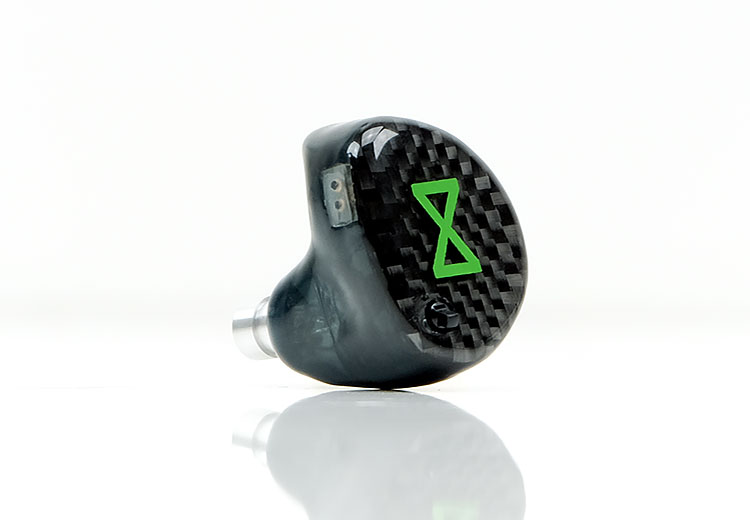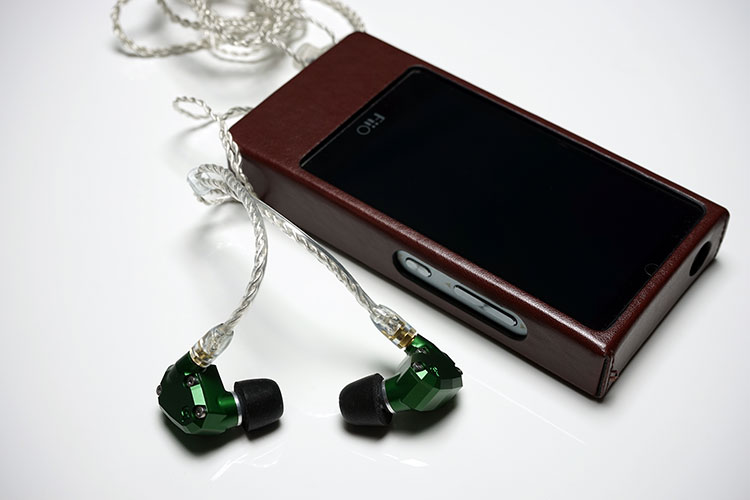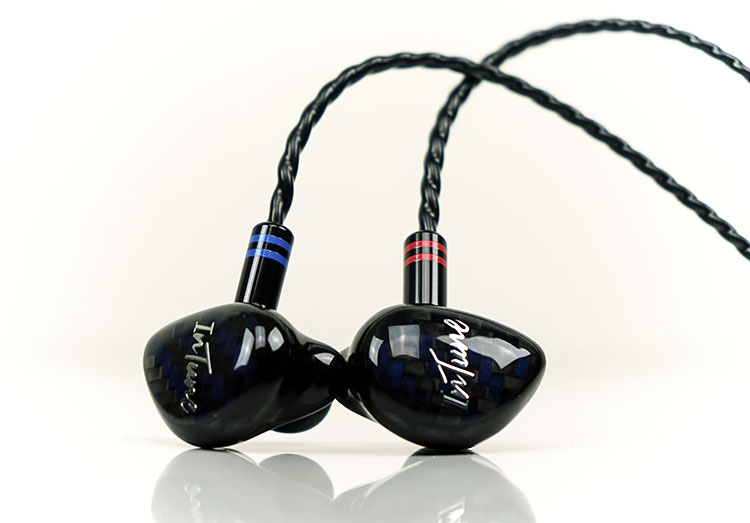Sound Impressions
There are two distinct sound signatures with the Model X with the use of the bass switch. The ‘bass-on’ response curve gets a 6dB boost up to around 600Hz though both have a fairly similar presentation from the upper-mids into the treble.
Bass Off
The first signature is with the bass switch down or bass-off and is relatively neutral sounding in the low-end, dipped in the mids and decent treble performance with a good extension around 8k.
You could argue that with bass-off it is very mildly U-shaped, except the dip is more 2-4k than 500Hz-1k similar to that of the IE800. Certainly, as with the custom version, this is a fairly balanced signature and a good reference point for all but the most bassy of tracks.
Instrumental timbre is relatively neutral in terms of stage positioning and timbre. The level of separation is very good actually with more than decent staging width but slightly less depth compared to height. The all BA tuning in bass-off has a good level of detail and speed right up to around 8k.
With the custom version, I found the treble extension to be more neutral to slight laid-back with the bass turned off. However, with the universal Model X, I found it a little “peppier” with a bit more sparkle.
Also, with the use of tips on the universal Model X, I found the amount of body just marginally less than the custom Model X unless I was using the foams. Some of that will be down to the level of leakage and how porous the tips you use are.
Bass On
With the Bass-On you get a + 6dB decrease on the low-end up to 600Hz which adds some significant body to the Model X, both in instrumental timbre and sub-bass presence as well as some mid-bass warmth. The signature takes on a more pronounced V-shape with the forward upper treble acting as a timely contrast preventing the sound from becoming dark or dull.
The boosted low-end on the Model X bass-on mode does mean you will hear a bit more body to instrumental timbre. Lower pitched instrumental work, particularly guitar work with sound richer and more authoritative on this switch setting much like the custom Model X.
Vocals for me do not actually change their position or presence with either switch but due to the more elevated nature of the low end with the bass-on mode they will struggle for a bit more air and fall a bit further back in the mix. When there is less bass energy, however, vocal timbre does sound a little fuller and warmer than when the bass mode is off which I prefer at times, especially for female vocals.
Staging does change on the Bass-On mode compared to Bass-Off. I find the depth to improve on the Bass-On mode with relatively the same level of height and air compared to the Bass-Off mode. With the bass turned off the Model X sounds more linear, not quite as deep or forward sounding but the mids are a bit more open and spacious sounding as a result.
Matchability
Efficiency
The Model X Universal plays the same cat and mouse game as the custom version so you will not find any impedance or SPL ratings on the webs page nor will team Lime Ears tell you. We had done some research before on the custom version to figure out just where it sits compared to other monitors.
You can find that data below for your reference including additional entries for the IT04 and the Fidue A91.
We selected the FiiO X7 with the AM3a using the single-ended output which will give us a nominal output impedance of around 1 ohm and 150-200mW of power depending on the impedance of the IEM in question. Testing was done on low gain with replay gain using FLAC 16BIT/44.1k files on FiiO Pure Player.
[table id=15 /]
Versus Custom Edition
In our testing with the Model X Universal, we found no substantive difference in volume settings from the custom version from similar sources such as the Sony 1Z, AK380, and the Lotoo Paw Gold. Tips did play a role in our testing and we found the slightly more porous nature of the SpinFits meant we pushed up the volume a little more than the foams.
Overall, the Model X universal edition is not going to cause any output power problems on moderate to powerful sources including most DAPs. DAPs tested included the Sony 1Z, FiiO X7ii, Lotoo PAW Gold Touch and the AK380.
Synergy
To sum DAP synergy up is more or less the same as the custom with some modest scaling capabilities. Pairing it with a portable amp will not hugely change the performance over a quality DAP. Power is not a necessary requirement though tonal tweaks will occur.
If I had a preference it would be the Sony 1Z and the AK380 where the Model X sounded just that bit smoother and more balanced to my ear, particularly with the bass-off setting which is more neutral in tone.
Cables
I felt this is one area that can substantially improve performance and synergy with the Model X. The Plastics One 4-wire OFC lacks dynamic range and volume with that small wire high resistance factor. Switching to an 8-wire or a good four wire makes a massive difference to the level of perceptible level of detail and more nuanced changes to the Model X timbre.
OC Studio Orpheus MK5
We tested it initially with the 8-wire OC Studio Orpheus MK5 which is less than $250 and the jump in dynamic range was immediate. This cable combined with the SpinFit tips sounded balanced, fuller in body and a more natural upper mids to treble sound over the stock cable.
With bass on the low-end sounded tighter and more impactful. It will not dramatically change the bias, it is still V-Shaped but it does sound more open and airy with the cable upgrade.
Effect Audio Leonidas 2
Effect Audio’s Leonidas 2, which is a 4-wire palladium-silver plated cable pulled the bass weight down a touch on the Model X but produced a much smoother treble and a very natural sounding instrumental timbre. The staging was also much more holographic sounding compared to the Plastics One cable with vocals breathing a little easier.
This combo will really suit those who like a slightly more forgiving top-end. Mind you the high price point might prove to be a bit of a barrier so my vote might go to the OC Studio cable at 1/3 of the cost of the Leonidas 2.
Select Comparisons
Fidue A91
$899
Technical
The A91 was launched in 2016 at a time when the hybrid driver design was still in relative infancy for monitors. This is a 5-driver design but with a quad BA setup for the mids and highs and a single 10mm dynamic driver for the lows.
Build
The build on both is quite different. The Model X goes for an acrylic and carbon fiber finish which is light and very comfortable. Fidue used a much more durable alloy material for the A91 so it is a lot more durable. However, the styling is less comfortable with a much shallower fit in the ear and lower levels of isolation. Tips can help a lot with the A91, especially foams but remember that dynamic driver is vented so it will never be world class.
Cables
The cables that come with the A91 is worth a special mention. The A91 uses an MMCX connection stock cable with a 2.5mm TRRS termination. It is a larger cable than the Plastics One of the Model X but just as quiet and tangle free. The nylon jacket of the A91 cable has a premium feel far and above the twisted PVC jacket of the model X stock cable.
More than that, the A91 cable comes with two piggy-tail connectors for 3.5mm TRS and 3.5mm TRRS balanced meaning those with iFi xDSD and xCANs can avail of their 3.5mm balanced outputs as well as slip on some 4.4mm converters for Sony gear.
Performance
The A91 is rated at 20Ω and 113dB so it is fairly sensitive for this type of build though not at Solaris levels. Whilst we do not know the exact rating for the Model X our previous testing had it around 18-25Ω and >109dB SPL.
In our testing with the Lotoo Paw Gold Touch and Sony 1Z, the Model X was the more sensitive of the two using similar foam tips though not by much. On the Sony 1Z this was around 4-5 steps in low gain unbalanced.
Tonality
A number of tonal differences here. The A91 low-end is a marginally more neutral than the bass down version of the Model X and far more discreet and linear than the bombastic bass up Model X alternative.
Right away though you can tell the difference in how the bass is delivered. The A91 has tremendous depth, spaciousness and a natural, slightly slower, level of decay compared to the Model X. The X is a little quicker and slightly warmer in bass off mode but doesn’t have that same level of sub-bass presence.
With the bass mode on you get more sub-bass presence and body but also additional mid-bass warmth. The Model X goes decidedly V-Shaped and almost the opposite in terms of tuning to the A91. The A91 has a fairly strong 1-3k mids boost compared to the Model X which is dips from 1-3k (even more so in bass mode on). Mids on the Model X are thus a bit more recessed and less suited to vocal lovers compared to the A91 more forward mids signature.
Treble on the A91 is a bit more focused on lower treble presence with a small peak up to 7k and then a slow roll-off beyond. The Model X has more of an 8-10k peak with both settings. Compared to the A91 it has a bit more treble extension and sparkle which does help to contrast and balance out the boosted low-end when the bass mode is on.
Campfire Andromeda
$1099
Technical
The Andromeda is near “classic” status these days in audiophile circles and certainly, we consider it a benchmark for all sorts of in-office testing. It is never far from a source in the Headfonics office. This is an all BA 5-driver universal monitor with a tubeless design (T.A.E.C) for the highs, an MMCX cable connection with a nice SPC Litz 3.5mm 1.32m unbalanced cable.
Build
The build differences are a bit like the A91 differences. The Model X universal is lighter with an acrylic build compared to the sturdier aluminum alloy of the Andromeda. However, the Achilles heel of the Andromeda has been that slightly uncomfortable fit due to the edging on the shell that is quite unforgiving for some. With the foam tips, the seal on both is quite similar in terms of passive isolation.
Performance
The Andromeda is rated at rated at 12.5 ohms and 115dB and until the Solaris and Phantom arrived I considered it to be one of the easiest monitors to drive but also one of the most sensitive. It is far more sensitive to gain and volume changes than the Model X.
That is not to say you need a portable amp for the Model X, rather, the Andromeda is just that sensitive. Hiss detector I call it and great for testing new DAP amp stages for noise.
Tonality
Tonally, the Andromeda is a little warmer in the mids with more of a forward vocal presence and generally sounding the more open of the two from 1-4k. The Model X with bass-on has more sub-bass presence and power as well as more mid-bass warmth and body. It will sound the more impactful of the two for bass but more diffuse in the mids.
If you want to tighten the bass-on performance and bring it closer to the Andromeda low-end then use the SpinFit tips which tended to sound a little more balanced than the foam tips.
With the bass-off on the Model X, it becomes much more neutral compared to the Andromeda and quite clean sounding with the less low-end body. However, mids will sound a bit more open and vocals have more presence on the Model X compared to the bass-on setting.
Both actually sound a little similar to me for upper treble being fairly forward and energetic sounding. The timber on the Model X treble is slightly different. It comes across as having a little less body and with the upper mids dip perhaps lacking in a little warmth. Neither really strike me as ‘splashy sounding’ or harsh sounding treble with a decent source.
iBasso IT04
$499
Technical
We thought we would bring a quad-driver monitor with a bit of a lower price just to get an idea on the value for money the Model X brings to the table. The IT04 is priced at just a cent under $500 and is also a 4-driver monitor. Like the A91, this is a hybrid design with a 10mm graphene diaphragm dynamic driver and a triple BA design for the mids and highs.
The BA configuration for the IT04 is 1 Knowles full-range ED driver and the 30017 dual-driver. The 30017 is technically 2 drivers so one driver is for the lower treble and one for the upper treble with the ED driver for the mids.
Build
Both use a similar build approach with acrylic and custom universal contouring for a comfortable and accurate fit. Both use a black smoked body and carbon fiber front plating. The only real visual difference is the slightly larger size of the IT04 due to the use of a 10mm dynamic driver and the monotone chrome labeling at the front compared to the green of the Model X.
I do prefer the aluminum nozzle of the Model X being both longer and stronger than the acrylic alternative on the IT04. It also has a better lip formation than the IT04 on the nozzle for keeping tips in place.
The IT04 uses an MMCX system compared to the 2-pin of the Model X which also adds a little girth at the top. The supplied 8-wire SPC and copper wire CB12s cable is a much better build and performance over the Plastics One on the Model X. It comes in balanced 2.5mm stock with a handy little 3.5mm piggy tail adaptor.
Performance
The IT04 is rated at 16Ω and 110dB and just marginally more sensitive than the Model X though not by a huge amount. With the Sony 1Z I think max about 3-4 steps between each other in terms of volume requirement in low gain unbalanced. Both have similar noise and ‘hiss performance’ levels and in short, that means pretty good.
Certainly not as sensitive as the likes of the Andromeda, Phantom, and the Solaris. Switching to balanced cables both did pick up a little bit of hiss with the balanced output of the FiiO X5iii and tube amps such as the Oriolus BA300s.
Tonality
The IT04 tuning is not that dissimilar to the Fidue A91 and as such you will find the differences to the Model X fairly similar also. The low-end is quite controlled but still unmistakably a dynamic driver in its texture, natural decay, and speed.
The Model X is a touch quicker and certainly far more neutral sounding with the bass off. It becomes warmer with more body than the IT04 with the bass on but still very much a BA low-end. Both have a dip in the mids but it is the lower-mids for the IT04 and the 2-4k range for the Model X. You could argue the Model X is far more V-Shaped in that regard than the IT04.
There is more of a vocal push on the IT04 with a boosted 1-4K range much like the A91 compared to that dip on the Model X which creates the perception of a larger stage but pushes the vocal further back in the mix. The Model X has more of a lower-treble presence than the IT04 which is a bit more muted whereas both have a decent 8-10k extension with good sparkle.
Of the two the IT04 has that kind of balance that suits vocals and hard rock. The Model X bass offsetting is a little too clean for hard rock though excellent for acoustics and finer detail. The bass-on version of the Model X does a better job with synth wave and hardcore EDM than the IT04.
Our Verdict
I think Lime Ears have done a good job getting very close to the custom version of the same monitor. The Model X Universal still retains that distinctive dual-signature tone of its custom sibling with a more neutral ‘bass-off’ and V-Shaped and fun-sounding ‘bass-on’ alternative.
This is still an excellent switch implementation with a very noticeable low-end change-up which is far more appealing than some of the subtler versions I have heard on other monitors down through the years.
Tips will make a difference though. With the custom monitor, I felt the sound a touch more relaxed sounding than the SpinFits and Symbio tips which tended to deliver a cleaner sound and a bit more treble presence. The foams took the universal Model X closer in performance and perhaps this is how I will use the Model X universal moving forward.
The only area I would focus on is the stock cable. This is the same cable on the custom monitor by the way so there is no disadvantage going universal. I do recommend grabbing a good 8-wire SPC or copper wire alternative because the Model X really sings when you up the dynamic range performance.
Other than that, Lime Ears have kept the Model X relevant, competitive, and importantly, available to buy right away without twiddling your thumbs for a few weeks.
Model X Universal Specifications
- 4 precision balanced armature drivers
- 3-way passive crossover design
- 2 balanced armature driver for low-frequency production
- 1 balanced armature drivers for midrange frequency production
- 1 balanced armature drivers for high-frequency production
- Sensitivity: unspecified
- Impedance: unspecified







